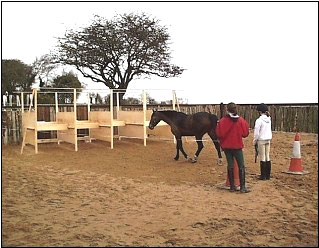| 2003 |

|
YEAR BOOK |
University of Limerick
|
How to choose your competition horse
|

The majority of owners within the disciplines of equitation have a general preference toward using male horses as the chosen competition animal. Stallions (entire males) and geldings (neutered males) are quite often physically bigger and stronger than fillies and mares (female horses) and may enjoy some athletic advantage as a result.
However, it is known from studies involving humans and small laboratory animals (mice and rats) that some gender differences in cognitive function may also affect performance where tasks involve elements of depth perception. We are attempting to get a better understanding of how horses actually perceive images of objects (like fences in show-jumping) and if male and female horses might deal with these perceptions differently. Visuo-spatial ability allows individuals (humans, horses and other animals) to interpret distance and depth perception and keep track of the spatial environment - in other words it is how we know where we are!
We designed a unique test apparatus to test the visuo-spatial ability of horses and ponies by conducting a series of novel experimental tests. The test apparatus is similar to a series of four stalls, each with a feed bin but also a barrier that either allows or prevents the animals' access to the feed bin. The horses had to choose one of the four stalls (specifically with the barrier in the appropriate position) in order to get access to the feed bin. During all tests, three out of four stalls had barriers positioned such that the horses were denied access to the feed bins.
Observers monitored the performance of the horses and recorded the length of time taken by each horse to access the feed bin. Some of the horses entered incorrect stalls (often more than once) and the number of such errors were also noted. A total of 62 animals, stallions (n = 1), geldings (n = 33) and mares (n = 28), have been put through their paces. Results to date have indicated that the male horses have performed better than the females during the series of tests.
Contact: Jack Murphy, Dept. of Life Sciences, University of Limerick; E-mail: [email protected]